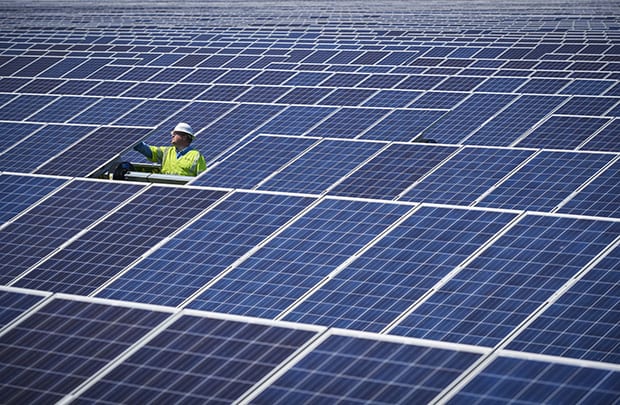Solar Power Is Economical Today, but Comes With Challenges
Credit to Author: Aaron Larson| Date: Wed, 27 Mar 2019 20:50:17 +0000
Depending on the deployment location and competing energy prices, photovoltaic solar panels are among the most cost-effective power solutions being added to the grid today, often without subsidies and other incentives.
The revelation came during a panel discussion—which included several CEOs from the power sector—that took place at the Bloomberg New Energy Finance (BNEF) Summit in New York on March 25. However, integrating high levels of solar power can be challenging for grid operators.
Case Study: Australia
Amy Grace, head of Cleantech Research with BNEF, moderated the session. She noted that Australia has experienced rapid growth in solar power over the past 10 years, with about one in five homes now having solar panels installed.
“We did a study last year that shows that going forward the cheapest thing to do for Australia is going to be wind, solar, storage, and some gas,” said Audrey Zibelman, CEO and managing director of the Australian Energy Market Operator, which is responsible for operating Australia’s largest gas and electricity markets and power systems.
Lynn Good, CEO of Duke Energy, seemed to agree. “We’re continuing progress toward clean energy. For Duke that means renewables, that means battery technology, and that means natural gas,” Good said.
Zibelman, who previously chaired the New York State Public Service Commission and is a former executive vice president and chief operating officer of the PJM Interconnection, said Australia has become a major exporter of natural gas. “We’ll be the largest exporter of natural gas in the next five years,” she said. The country is also a major exporter of coal. As a result, prices have been driven up for both commodities. That has given renewable energy a competitive advantage.
“In Australia, we’re adding six solar panels every minute on roofs,” Zibelman said. She noted that in Western Australia, which has an average power demand of 2,000 MW, there is 1,000 MW of rooftop solar installed. “So, every time there’s cloud cover coming over, our voltage drops significantly,” she said.
Solar Power in North Carolina
Good noted that North Carolina has the second-largest installed capacity of solar power in the U.S. behind only California. The majority of North Carolina’s solar power is deployed in utility-scale systems—many of which are located in the eastern part of the state (Figure 1). Good suggested integration challenges are not limited to rooftop installations. She offered an example from just a few weeks earlier.
“We had so much solar on the system on a Sunday afternoon, yet we knew that Monday morning we were going to wake up to 25-degree weather. The peak for us in the Carolinas occurs in the winter around 7:00 to 7:30—dark—solar is not going to be there. We don’t have enough battery storage in place to accommodate all of that and move us from Sunday to Monday. And so, we did some curtailment of that solar to ramp up other resources that we were going to need on Monday morning. So that forecasting flexibility and the resources we bring to the table, curtailment, we don’t like to do it, but there may be circumstances like in which we need to do it. And I see that increasing amount of intermittency in our system driving us to even more work in all of those areas—better forecasting, more flexible resources, looking for ways we can continue to add to the system in a way that makes that reliability work,” Good said.
Lessons Learned
Zibelman suggested the U.S. could learn some lessons from Australia’s experience. For one, she said environmental and energy policies need to be integrated. “You can’t really make this transition unless your emissions goals are also integrated into your energy reliability requirements.”
The second lesson is that good planning is needed. “The power system we developed in the last century isn’t really the power system we’re going to need for high levels of renewables. So, the kind of investments we’re going to need are very different,” said Zibelman.
Good suggested continued dialog stakeholders, regulators, legislators, and customers was needed, because “often the conversation wants to go into a single direction, ‘Let’s put more renewables on the system,’ and we need to broaden that conversation to ‘How are we going to accommodate more renewables within an energy system that still maintains affordability and reliability?’ ” she said.
New Technology Is Key
“I look at the aspirations we have at Duke to lower carbon by 40% to 50% by 2030. We’re at 30% today. I believe the technologies that we have available to us can get us to that level. So, we’re talking about renewables, we’re talking about retirement of coal, natural gas, battery technology, increasing pumped storage, maintaining the nuclear fleet,” Good said.
“I think once we get past 2030, and we’re trying to go even deeper to 80%, to 100%, then we start looking for other solutions. A breakthrough technology, maybe around batteries. Is there carbon capture? Is there advanced nuclear going to show up? Are there more energy efficiency investments that we can make? Of course, those would be all along the way,” said Good. “But I think we need to recognize that we do not have all the technologies at our disposal right now to go to 100% reduction of carbon,” she added, noting that continued research and development will be crucial for success.
—Aaron Larson is POWER’s executive editor (@AaronL_Power, @POWERmagazine).
The post Solar Power Is Economical Today, but Comes With Challenges appeared first on POWER Magazine.
